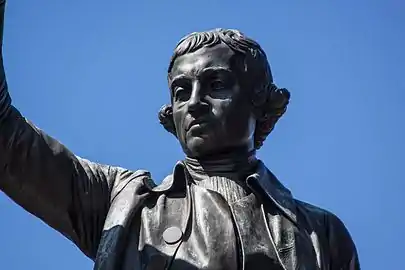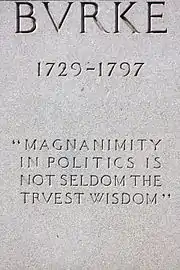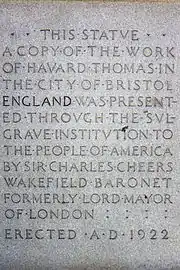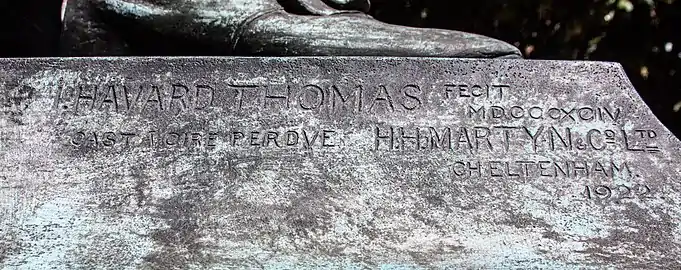Edmund Burke | |
.jpg.webp) Statue of Edmund Burke in 2012 | |
| Location | 11th Street, L Street, and Massachusetts Avenue NW, Washington, D.C. |
|---|---|
| Coordinates | 38°54′14″N 77°1′38.8″W / 38.90389°N 77.027444°W |
| Built | 1894, second cast 1922 |
| Architect | James Havard Thomas (sculptor) Horace W. Peaslee (architect) M. H. Martyn Company (founder) New England Granite Works (fabricator) |
| NRHP reference No. | 78000256[1] |
| Significant dates | |
| Added to NRHP | July 14, 1978 (American Revolution Statuary) |
| Designated | April 24, 1997 (L'Enfant Plan) September 9, 1999 (Mount Vernon West Historic District) |
| Designated DCIHS | March 3, 1979 (American Revolution Statuary) April 24, 1997 (L'Enfant Plan) July 22, 1999 (Mount Vernon West Historic District) |
Edmund Burke is a bronze, full-length statue of British statesman, author, orator, political theorist, and philosopher Edmund Burke by British artist James Havard Thomas. The original statue is in Bristol, England, with a second cast in Washington, D.C. The statue in Washington, D.C., stands in Burke Park, at the intersection of 11th Street, L Street, and Massachusetts Avenue NW, on the southern border of the Shaw neighborhood. The statue was a gift from the Charles Wakefield, 1st Viscount Wakefield, on behalf of the Sulgrave Institution, an organization that wanted to celebrate United Kingdom–United States relations. One way the group did this was by exchanging statues and busts between the two countries.
Burke is known as one of the greatest philosophers of his time. After working as a private secretary for William Gerard Hamilton followed by Prime Minster Charles Watson-Wentworth, 2nd Marquess of Rockingham, Burke was elected to the House of Commons where he would often give powerful speeches during his 30-year tenure. During the leadup to the American Revolutionary War, he often spoke about the hardships Britain was placing on the Thirteen Colonies. He feared if a war took place, Britain would lose. After the United States was formed after the British loss, Burke attempted to mend the relationship via peace treaties and trade.
The statue of Burke is 8-feet tall (2.4 m) and stands on a pedestal designed by Horace W. Peaslee. It was formally dedicated in October 1922 at an event attended by prominent citizen, diplomats, and members of the public. The statue is one of 14 American Revolution Statuary in Washington, D.C., that were collectively listed on the National Register of Historic Places in 1978 and the District of Columbia Inventory of Historic Sites the following year. In addition, the statue is a contributing property to the L'Enfant Plan and the Mount Vernon West Historic District, also known as the Shaw Historic District.
History
Biography
Edmund Burke was born around 1729 in Dublin, Ireland, and later received education at Trinity College Dublin.[2] While at school, he began a debate group, the precursor to the College Historical Society. In the 1750s Burke began writing, starting with A Vindication of Natural Society, followed by A Philosophical Enquiry into the Origin of Our Ideas of the Sublime and Beautiful.[3] Although he had some success in writing, Burke began dabbling in politics. He was the private secretary of William Gerard Hamilton, and beginning in 1765, the private secretary to Charles Watson-Wentworth, 2nd Marquess of Rockingham, who was Prime Minster at the time.[4]
He was elected to the House of Commons later that year, the beginning of a 30-year career in Parliament.[2] He became an active PM who stood up for religious tolerance, finance reform, liberty, and the affairs of the Thirteen Colonies. He adamantly opposed the heavy taxation imposed on the colonies, and often defended them while speaking in Parliament.[2][4] Although he never went so far as to call for independence of the colonies, he did think starting a war with them would lead to a British defeat.[2]
When the American Revolutionary War began, Burke continued his defense of the colonies. Because his political party, the Whigs, was out of power during the war, the Tories and King George III were responsible for the continuation and eventual loss of the colonies. Burke tried to soften the hostility between Great Britain and the newly formed United States of America by encouraging trade and peace between the two countries. He served roles as Paymaster of the Forces and Rector of the University of Glasgow during his later years. He died in 1797. He left a legacy that has inspired many conservatives and has been called "one of the great philosophers of the Enlightenment".[2]
Planning and dedication
In the early 1920s, a group called the Sulgrave Institution, which William Howard Taft said was "an organization to strengthen the bonds between Great Britain and the United States" and was named after Sulgrave Manor had made strengthening the bond between the UK and US. The Sulgrave Institution, on behalf of Charles Wakefield, 1st Viscount Wakefield, the former Lord Mayor of London and member of the organization, gifted the statue of a person who stood up for the US when it was engulfed in war.[2][4] The statue they chose of Burke is a cast of the 1894 statue of Edmund Burke in Bristol, England. Sculpted by James Havard Thomas, the idea behind installation of the statue was to further strengthen the bonds between the two countries after working together during World War I. One way to do this was the installation of busts and statues of well-known British and American people in each other's countries. Statues and busts exchanged between the UK and the US included Alexander Hamilton, Abraham Lincoln, William Pitt the Younger, and former US ambassador to the UK, Joseph Hodges Choate.[2][5]
On April 25, 1922, an Act of Congress approved the statue's installation.[6] The architect chosen to design the statue's base was Horace W. Peaslee, although this was not installed until June 1923. A temporary base was sculpted by Frederick D. Owen. The original statue was founded by M. H. Martyn Company and the stonework was completed by New England Granite Works.[7] The statue was installed in September 1922, but the official unveiling and dedication ceremony did not take place until October 12 of that year. A few weeks before the ceremony took place, it was announced children from the nearby Webster School and Thomson School would participate by singing songs and waving flags.[5]
The invocation for the ceremony was given by Reverend George C. F. Bratenahl from the Washington Cathedral. British and American diplomats, including the UK ambassador at the time, Auckland Geddes, 1st Baron Geddes, joined others at the event. Prominent attendees included Secretary Charles Evans Hughes and Samuel Gompers. Wakefield and Secretary John W. Weeks each gave speeches praising Burke and the UK-US relations at the event. Weeks accepted the statue on behalf of all Americans. Reverend John I. Barrett from St. Patrick's Catholic Church gave the benediction.[5][8][9]
Later history
The statue is one of 14 American Revolution Statuary that were collectively listed on the National Register of Historic Places (NRHP) on July 14, 1978. The statuary was added to the District of Columbia Inventory of Historic Sites (DCIHS) on March 3, 1979. Because of its location on government-owned property, the statue is a contributing property to the L'Enfant Plan, listed on the NRHP and DCIHS on April 24, 1997. In addition, the statue is a contributing property to the Mount Vernon West Historic District, also known as the Shaw Historic District, which was added to the DCIHS on July 22, 1999, followed by the NRHP a few months later on September 9, 1999.[10][11][12]
Location and design
The statue is located in Reservation 68, a triangular plot of land named Burke Park. The park is located at the intersection of 11th Street, L Street, and Massachusetts Avenue NW, on the southern border of the Shaw neighborhood. In 2012 several trees were planted in the park.[13] Because the park is owned by the federal government, the statue is maintained by the National Park Service.[14]
The full length sculpture of Burke, which measures 8-feet tall (2.4 m), depicts him stepping forward with his right leg. He is waving his right hand, and in his left hand he holds a three-cornered hat at his side. He wears a long jacket, a vest, and breeches. His hair curls up just above his ears and is parted down the middle. The sculpture sits upon a rectangular granite base which measures 6-feet (1.8 m) by 7.7-feet (2.3 m). The bottom of the statue is signed: I. HAVARD THOMAS FECIT MDCCCXCIV CAST Á CIRE PERDVE H.H. MARTYN & Co. Ltd. Cheltenham 1922.[7]
The front (east) side of the base is inscribed with:[15]
BVRKE
1729–1797
"MAGNANIMITY
IN POLITICS IS
NOT SELDOM THE
TRVEST WISDOM"
The west side of the base is inscribed with:[7]
THIS STATVE
A COPY OF THE WORK
OF HAVARD THOMAS IN
THE CITY OF BRISTOL
ENGLAND WAS PRESENT-
ED THROVGH THE SVL-
GRAVE INSTITVTION TO
THE PEOPLE OF AMERICA
BY SIR CHARLES CHEERS
WAKEFIELD BARONET
FORMERLY LORD MAYOR
OF LONDON
ERECTED A.D. 1922[7]
Gallery
 Full-angled view
Full-angled view Closeup
Closeup Front inscription
Front inscription Back inscription
Back inscription Sculptor signature and founder data
Sculptor signature and founder data
See also
References
- ↑ "National Register Information System". National Register of Historic Places. National Park Service. July 9, 2010.
- 1 2 3 4 5 6 7 "Edmund Burke Memorial". National Park Service. Archived from the original on December 30, 2023. Retrieved January 2, 2024.
- ↑ McCue, Jim (1997). Edmund Burke and Our Present Discontents. Claridge Press. p. 14. ISBN 9781870626170.
- 1 2 3 Goode, James M. (1974). The outdoor sculpture of Washington, D.C. Smithsonian Institution Press. p. 277.
- 1 2 3 "Burke Statue for Washington Gift of the Sulgrave Institute". The Evening Star. April 8, 1922. p. 6. Archived from the original on December 30, 2023. Retrieved January 2, 2024.
- ↑ Scott, Gary (October 3, 1977). "National Register of Historic Places Nomination Form - American Revolution Statuary". National Park Service. Archived from the original on September 29, 2022. Retrieved January 2, 2024.
- 1 2 3 4 "Edmund Burke, (sculpture)". Smithsonian Institution Research Information System. Archived from the original on December 30, 2023. Retrieved January 2, 2024.
- ↑ "Steps to Help Unveil Memorial to Edmund Burke". The Washington Herald. October 8, 1922. p. 2. Archived from the original on December 30, 2023. Retrieved January 2, 2024.
- ↑ "Burke and Bryce Memorials Given D.C. at Services". The Washington Herald. October 13, 1922. p. 3. Archived from the original on December 30, 2023. Retrieved January 2, 2024.
- ↑ "District of Columbia Inventory of Historic Sites" (PDF). District of Columbia Office of Planning – Historic Preservation Office. September 30, 2009. Archived (PDF) from the original on July 31, 2017. Retrieved January 2, 2024.
- ↑ Leach, Sara Amy; Barthold, Elizabeth (July 20, 1994). "National Register of Historic Places Registration Form - L'Enfant Plan of the City of Washington, District of Columbia" (PDF). National Park Service. Archived (PDF) from the original on November 5, 2017. Retrieved January 2, 2024.
{{cite web}}: CS1 maint: multiple names: authors list (link) - ↑ Trieschmarm, Laura V. (July 27, 1999). "National Register of Historic Places Nomination Form - Mount Vernon West Historic District" (PDF). National Park Service. Archived (PDF) from the original on February 10, 2023. Retrieved January 2, 2024.
- ↑ "Burke Park (Reservation 68)". DowntownDC. Archived from the original on December 30, 2023. Retrieved January 1, 2024.
- ↑ "Edmund Burke Statue". DC Preservation League. Archived from the original on December 30, 2023. Retrieved January 1, 2024.
- ↑ "Edmund Burke Statue". National Park Service. Archived from the original on December 30, 2023. Retrieved January 1, 2024.
External links
 Media related to Statue of Edmund Burke (Washington, D.C.) at Wikimedia Commons
Media related to Statue of Edmund Burke (Washington, D.C.) at Wikimedia Commons